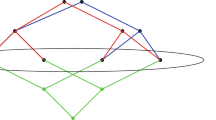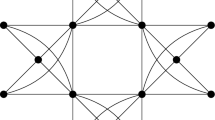Abstract
Based on a technique of Barvinok [4,5,6] and Barvinok and Soberón [8,9] we identify a class of edge-coloring models whose partition functions do not evaluate to zero on bounded degree graphs. Subsequently we give a quasi-polynomial time approximation scheme for computing these partition functions. As another application we show that the normalised partition functions of these models are continuous with respect to the Benjamini-Schramm topology on bounded degree graphs. We moreover give quasi-polynomial time approxi-mation schemes for evaluating a large class of graph polynomials, including the Tutte polynomial, on bounded degree graphs.
Similar content being viewed by others
References
M. Abért and T. Hubai: Benjamini-Schramm convergence and the distribution of chromatic roots for sparse graphs, Combinatorica 35 (2015), 127–151.
I. Arad and Z. Landau: Quantum computation and the evaluation of tensor networks, SIAM Journal on Computing 39 (2010), 3089–3121.
M. Bayati, D. Gamarnik, D. Katz, C. Nair and P. Tetali: Simple deterministic approximation algorithms for counting matchings, in: Proceedings of the thirty-ninth annual ACM symposium on Theory of computing 122–127, ACM, 2007.
A. Barvinok: Computing the permanent of (some) complex matrices, Foundations of Computational Mathematics (2014), 1–14.
A. Barvinok: Computing the partition function for cliques in a graph, Theory of Computing 11 (2015), 339–355.
A. Barvinok: Computing the partition function of a polynomial on the Boolean cube, arXiv preprint, arXiv:1503.07463 (2015).
A. Barvinok: Approximating permanents and hafnians, Discrete Analysis 2 (2017).
A. Barvinok and P. Soberón: Computing the partition function for graph homomorphisms, Combinatorica 36 (2016), 1–18.
A. Barvinok and P. Soberón: Computing the partition function for graph homomorphisms with multiplicities, Journal of Combinatorial Theory, Series A 137 (2016), 1–26.
I. Benjamini and O. Schramm: Recurrence of distributional limits of finite planar graphs, in: Selected Works of Oded Schramm, 533–545, Springer New York, 2011.
C. Borgs, J. Chayes, J. Kahn and L. Lovász: Left and right convergence of graphs with bounded degree, Random Structures and Algorithms 42 (2013), 1–28.
R. Bubley, M. Dyer, C. Greenhill and M. Jerrum: On approximately counting colorings of small degree graphs, SIAM Journal on Computing 29 (1999), 387–400.
A. Bulatov and M. Grohe: The complexity of partition functions, Theoretical Computer Science 348 (2005), 148–186.
J. Cai, X. Chen and P. Lu: Graph homomorphisms with complex values: A dichotomy theorem, SIAM Journal on Computing 42 (2013), 924–1029.
J. Cai, H. Guo and T. Williams: A complete dichotomy rises from the capture of vanishing signatures, in: Proceedings of the forty-fifth annual ACM symposium on Theory of computing, 635–644. ACM, 2013.
J. Cai, S. Huang and P. L: From Holant to #CSP and Back: Dichotomy for Holantc Problems, in: ISAAC, 253–265, 2010.
J. Cai, P. Lu and M. Xia: Holant problems and counting CSP, in: Proceedings of the 41st annual ACM symposium on Theory of computing, STOC 09, 715–724, New York, NY, USA, 2009.
J. Cai, P. Lu and M. Xia: Computational complexity of Holant problems, SIAM Journal on Computing 40 (2011), 1101–1132.
P. Csikvári and P. E. Frenkel: Benjamini–Schramm continuity of root moments of graph polynomials, European Journal of Combinatorics 52 (2016), 302–320.
P. de la Harpe and V.F.R. Jones: Graph invariants related to statistical mechanical models: examples and problems, Journal of Combinatorial Theory, Series B 57 (1993), 207–227.
J. Draisma, D. Gijswijt, L. Lovász, G. Regts and A. Schrijver: Characterizing partition functions of the vertex model, Journal of Algebra 350 (2012), 197–206.
M. Dyer and C. Greenhill: The complexity of counting graph homomorphisms, Random Structures and Algorithms 17 (2000), 260–289.
A. Galanis, D. Stefankovic, E. Vigoda and L. Yang: Ferromagnetic Potts model: Refined #BIS-hardness and related results, in: RANDOM 2014, LNCS 6845, 677–691 2014. Full version available at arXiv:1311.4839.
D. Gamarnik and D. Katz: Correlation decay and deterministic FPTAS for counting list-colorings of a graph, Journal of Discrete Algorithms 12 (2012), 29–47.
L. A. Goldberg and M. Jerrum: Approximating the partition function of the ferromagnetic Potts model, Journal of the ACM 59 (2012), 1–25.
L. A. Goldberg, M. Jerrum and C. McQuillan: Approximating the partition function of planar two-state spin systems, Journal of Computer and System Sciences 81 (2015), 330–358.
B. Jackson, A. Procacci and A. D. Sokal: Complex zero-free regions at large jqj for multivariate Tutte polynomials (alias Potts-model partition functions) with general complex edge weights, Journal of Combinatorial Theory, Series B 103 (2013), 21–45.
T. Lee and T. Yang: Statistical theory of equations of state and phase transitions. I. Theory of condensation, Physical Review 87 (1952), 404.
L. Lovász: Large Networks and Graph Limits, Vol. 60, American Mathematical Society, Providence, Rhode Island, 2012.
L.M. Lovász: A short proof of the equivalence of left and right convergence for sparse graphs, European Journal of Combinatorics 53 (2016), 1–7.
P. Lu and Y. Yin: Improved FPTAS for multi-spin systems, in: Approximation, Randomization, and Combinatorial Optimization. Algorithms and Techniques, 639–654, Springer Berlin Heidelberg, 2013.
I. L. Markov and Y. Shi: Simulating quantum computation by contracting tensor networks, SIAM Journal on Computing 38 (2008), 963–981.
V. Patel and G. Regts: Deterministic polynomial-time approximation algorithms for partition functions and graph polynomials, arXiv preprint arXiv:1607.01167, 2016.
G. Regts: Graph Parameters and Invariants of the Orthogonal Group, PhD thesis, University of Amsterdam, 2013.
A. D. Scott and A. D. Sokal: The repulsive lattice gas, the independent-set polynomial, and the Lovász local lemma, Journal of Statistical Physics 118 (2005), 1151–1261.
A. Sinclair, P. Srivastava and M. Thurley: Approximation algorithms for two-state anti-ferromagnetic spin systems on bounded degree graphs, Journal of Statistical Physics 155 (2014), 666–686.
A. Sly and N. Sun: The computational hardness of counting in two-spin models on d-regular graphs, in: Proceedings of the 53rd Annual Symposium on Foundations of Computer Science (FOCS), 2012 IEEE, 361–369. IEEE, 2012.
B. Szegedy: Edge-coloring models and re ection positivity, Journal of the American Mathematical Society 20 (2007), 969–988.
B. Szegedy: Edge coloring models as singular vertex-coloring models, in: Fete of Combinatorics and Computer Science (G. O. H. Katona, A. Schrijver, T. Szonyi, editors), Springer, Heidelberg and János Bolyai Mathematical Society, Budapest (2010), 327–336.
D. Weitz: Counting independent sets up to the tree threshold, in: Proceedings of the thirty-eighth annual ACM symposium on Theory of computing, STOC 06, 140–149, New York, NY, USA, 2006. ACM.
Author information
Authors and Affiliations
Corresponding author
Rights and permissions
About this article
Cite this article
Regts, G. Zero-Free Regions of Partition Functions with Applications to Algorithms and Graph Limits. Combinatorica 38, 987–1015 (2018). https://doi.org/10.1007/s00493-016-3506-7
Received:
Revised:
Published:
Issue Date:
DOI: https://doi.org/10.1007/s00493-016-3506-7




